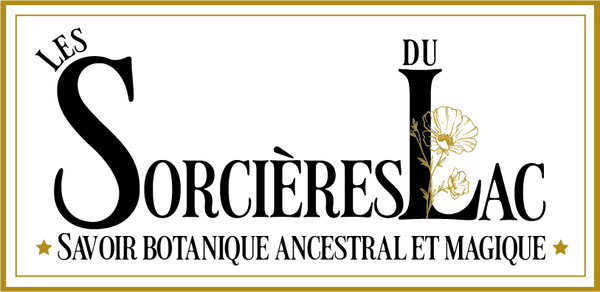
Enchanted parenthesis No. 1
- The poppy -
A wild flower
Fragile and strong at the same time, this pretty red flower with a black heart and a slender stem bristling with small hairs, embodies the little miracles of nature.
The poppy is said to take its name from the old French "Coquerico", the equivalent of our current "Cocorico", in reference to its red color and its slightly crumpled petals, reminiscent of a rooster's crest. But it also has other names: Field poppy, Wild poppy, Papaver, Corn Poppy or Kollenbloem in Dutch dialect which would mean Bloem/flower and Kollen/witch. Among the witches of the lake, we have a slight preference for the latter, even if the name Field poppy, or Wild poppy perfectly sums up our attachment to a nature that does as it pleases ... a bit like witches in fact. It is also said that the Latin name papaver for the poppy comes from the word "papa' meaning "porridge": in the past, poppy petals were added to children's porridge to help them sleep.
This flower is a fantastic weed that brightens, colors and awakens the blondness of fields, roadsides and paths, orchards and clearings throughout the Spring and Summer. The transition from winter humidity to summer drought triggers the appearance of poppies.
It is a messicole plant, which means that its life cycle is adapted to agricultural crops. A symbol of resilience, the poppy reseeds itself every year. It has been present in cultivated fields for thousands of years: Poppy seeds have been found mixed with barley grains dating back to ancient Egypt.
Native to North Africa and Eurasia, it is known for its delicate appearance, but it is actually capable of growing in unlikely places. A lover of sunny places, it blooms from May to July and generates new seeds throughout the summer season, before the harvest, which will rest in the soil until next Spring. A poppy plant can produce up to 50,000 seeds. These keep their germination capacity in the soil for a long time, generally between 5 to 8 years, but it is said that they could remain dormant for more than 80 years.
Its existence dates back to ancient times and it has been known for its medicinal properties for thousands of years. It is used in the form of syrup or infusion to calm coughs, relieve sore throats, promote sleep, reduce sleep disorders or anxiety. The poppy is the flower of appeasement.
A symbolic flower
In Greek mythology, the poppy is associated with Demeter, the goddess of agriculture and harvests. According to legend, when her daughter Persephone was kidnapped by Hades, the god of the underworld, Demeter wandered desperately in search of her. She eventually found her, but she could only return during the spring months. So each year, when it blooms, it recalls the return of Persephone and marks the beginning of Spring and Renewal.
He is also the symbol of Morphes, God of dreams and the night, who gives sleep to mortals by touching them with the petals of the poppy.
In ancient Egypt, poppies were placed in tombs to promote eternal rest.
The poppy is above all the flower of symbols.
It is associated with peace, sacrifice and the fragility of life. It is recognized as an emblem of remembrance for the Anglo-Saxons of the Second World War, because it flourished around the trenches, on the graves of soldiers and its red color was reminiscent of the color of blood.
It is also the symbol of life, fullness, happiness and freedom. In China or Japan, it represents passionate love.
It is the plant of comfort, consolation and troubled souls.
A poetic flower
The poppy is a flower full of poetry. Many artists such as Claude Monet, Gustave Courbet, Gustav Klimt and Vincent Van Gogh have highlighted this small flower with its solitary and ephemeral character in many of their works.
It is in the early morning that the green and hairy bud of the poppy begins to straighten up. These petals all crumpled inside come out of their bed, stretch and unfold. The flower is wide open and offers its black crown of hundreds of stamens and thousands of pollen grains to whoever wants it. The poppy is a honey plant which means that it is used by bees to produce honey, but it is one of the rare flowers that does not secrete nectar but pollen. The bees are not guided by its red color but by the UV rays that these petals reflect. The black center of the flower stores the heat that it redistributes. In its heart, the flower could have a higher temperature thus attracting insects. Thus attracted, the bees approach the flower then sting towards the center in this darker and warmer area. Pollen grains attach themselves to the legs of the bees and bumblebees to then end up on the pistils of other flowers. The poppy flower usually fades and falls asleep after a morning, a day or at most after having played its role with the bees and amazed our eyes.
Beliefs and popular folklore
It is said:
- That a small bag of poppy seeds under the pillow promotes sleep and promises sweet dreams, it's a good thing there is poppy in "La tisane les herbes ensorcelées" .
- That it stimulates creativity, that it is the ideal amulet for writers and artists and witches without a doubt.
- To know if you are loved, you snap a poppy petal in your hands; the intensity of the noise indicates the intensity of the feeling.
- Let thunder clap when the poppy is picked.
In any case, in Les sorcières du lac, the poppy is a symbol of benevolence, effervescence and transparency.
